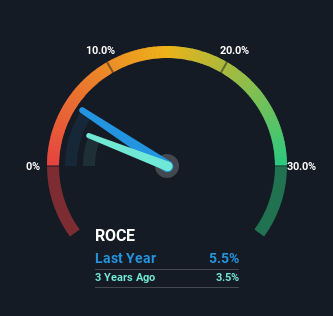- Israel
- /
- Medical Equipment
- /
- TASE:ENDY
Here's What's Concerning About Endymed's (TLV:ENDY) Returns On Capital

Did you know there are some financial metrics that can provide clues of a potential multi-bagger? One common approach is to try and find a company with returns on capital employed (ROCE) that are increasing, in conjunction with a growing amount of capital employed. Ultimately, this demonstrates that it's a business that is reinvesting profits at increasing rates of return. However, after briefly looking over the numbers, we don't think Endymed (TLV:ENDY) has the makings of a multi-bagger going forward, but let's have a look at why that may be.
What Is Return On Capital Employed (ROCE)?
If you haven't worked with ROCE before, it measures the 'return' (pre-tax profit) a company generates from capital employed in its business. To calculate this metric for Endymed, this is the formula:
Return on Capital Employed = Earnings Before Interest and Tax (EBIT) ÷ (Total Assets - Current Liabilities)
0.055 = US$922k ÷ (US$20m - US$3.9m) (Based on the trailing twelve months to December 2023).
Thus, Endymed has an ROCE of 5.5%. In absolute terms, that's a low return and it also under-performs the Medical Equipment industry average of 8.4%.
Check out our latest analysis for Endymed

While the past is not representative of the future, it can be helpful to know how a company has performed historically, which is why we have this chart above. If you want to delve into the historical earnings , check out these free graphs detailing revenue and cash flow performance of Endymed.
So How Is Endymed's ROCE Trending?
When we looked at the ROCE trend at Endymed, we didn't gain much confidence. Around five years ago the returns on capital were 28%, but since then they've fallen to 5.5%. On the other hand, the company has been employing more capital without a corresponding improvement in sales in the last year, which could suggest these investments are longer term plays. It's worth keeping an eye on the company's earnings from here on to see if these investments do end up contributing to the bottom line.
On a side note, Endymed has done well to pay down its current liabilities to 19% of total assets. That could partly explain why the ROCE has dropped. What's more, this can reduce some aspects of risk to the business because now the company's suppliers or short-term creditors are funding less of its operations. Some would claim this reduces the business' efficiency at generating ROCE since it is now funding more of the operations with its own money.
The Key Takeaway
To conclude, we've found that Endymed is reinvesting in the business, but returns have been falling. And investors may be recognizing these trends since the stock has only returned a total of 2.3% to shareholders over the last five years. So if you're looking for a multi-bagger, the underlying trends indicate you may have better chances elsewhere.
Endymed does have some risks, we noticed 4 warning signs (and 1 which is a bit unpleasant) we think you should know about.
While Endymed isn't earning the highest return, check out this free list of companies that are earning high returns on equity with solid balance sheets.
Valuation is complex, but we're here to simplify it.
Discover if Endymed might be undervalued or overvalued with our detailed analysis, featuring fair value estimates, potential risks, dividends, insider trades, and its financial condition.
Access Free AnalysisHave feedback on this article? Concerned about the content? Get in touch with us directly. Alternatively, email editorial-team (at) simplywallst.com.
This article by Simply Wall St is general in nature. We provide commentary based on historical data and analyst forecasts only using an unbiased methodology and our articles are not intended to be financial advice. It does not constitute a recommendation to buy or sell any stock, and does not take account of your objectives, or your financial situation. We aim to bring you long-term focused analysis driven by fundamental data. Note that our analysis may not factor in the latest price-sensitive company announcements or qualitative material. Simply Wall St has no position in any stocks mentioned.
About TASE:ENDY
Endymed
Provides energy based medical aesthetic treatment systems for the professional and consumer markets in North America, Europe, the Middle East, Africa, Asia, Oceania, Latin America, and internationally.
Flawless balance sheet and slightly overvalued.
Market Insights
Community Narratives



